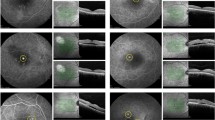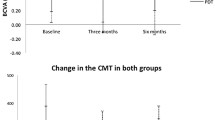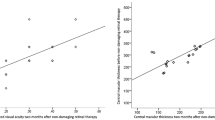Abstract
Purpose
To evaluate the efficacy of navigated focal laser photocoagulation in patients with chronic central serous chorioretinopathy (CSCR) and active leakage on fluorescein angiography (FA).
Methods
Thirty-two eyes of 32 patients (age 48 ± 11, m/f = 24/8) with persistent or recurrent CSCR (> 3 months) who received navigated laser photocoagulation (Navilas®) of leaking point(s) between June 2013 and 2016 were included in this retrospective case series. Outcome parameters after 4 weeks and 3 months were the number of patients presenting with complete resolution of subretinal fluid, the volume of subretinal fluid measured on SD-OCT (Spectralis Heidelberg Engineering©), and best corrected visual acuity (BCVA/ (Snellen equivalent).
Results
Complete resolution of subretinal fluid was achieved in 17 eyes (50%) after 4 weeks and in 24 eyes (75%) after 3 months with an average number of 1.3 laser procedures (range 1–3). Five eyes displayed a nearly complete resolution with a reduction of over 80% of the subretinal fluid compared to baseline. Three eyes showed no reduction in subretinal fluid. BCVA improved from median 0.58 (range 0.16–1.25) to 0.66 (0.16–1.0) (p = 0.001). The seven patients who had been treated within the central 1 mm of the ETDRS-OCT Grid but outside the avascular foveal zone showed an improvement of BCVA from median 0.6 (range 0.2–1.0) to 0.8 (0.2–1.0). No patient experienced a treatment-induced visual loss.
Conclusions
Laser treatment with Navilas® using eye tracking and FA-based planning is a safe and effective alternative therapy in patients with chronic CSCR.




Similar content being viewed by others
References
Daruich A, Matet A, Dirani A, Bousquet E, Zhao M, Farman N, Jaisser F, Behar-Cohen F (2015) Central serous chorioretinopathy: recent findings and new physiopathology hypothesis. Prog Retin Eye Res 48:82–118. https://doi.org/10.1016/j.preteyeres.2015.05.003
Kitzmann AS, Pulido JS, Diehl NN, Hodge DO, Burke JP (2008) The incidence of central serous chorioretinopathy in Olmsted County, Minnesota, 1980-2002. Ophthalmology 115:169–173. https://doi.org/10.1016/j.ophtha.2007.02.032
Tewari HK, Gadia R, Kumar D, Venkatesh P, Garg SP (2006) Sympathetic-parasympathetic activity and reactivity in central serous chorioretinopathy: a case-control study. Invest Ophthalmol Vis Sci 47:3474–3478. https://doi.org/10.1167/iovs.05-1246
Conrad R, Geiser F, Kleiman A, Zur B, Karpawitz-Godt A (2014) Temperament and character personality profile and illness-related stress in central serous chorioretinopathy. TheScientificWorldJournal 2014:631687. https://doi.org/10.1155/2014/631687
Zakir SM, Shukla M, Simi ZU, Ahmad J, Sajid M (2009) Serum cortisol and testosterone levels in idiopathic central serous chorioretinopathy. Indian J Ophthalmol 57:419–422. https://doi.org/10.4103/0301-4738.57143
Haimovici R, Rumelt S, Melby J (2003) Endocrine abnormalities in patients with central serous chorioretinopathy. Ophthalmology 110:698–703. https://doi.org/10.1016/S0161-6420(02)01975-9
Khairallah M, Kahloun R, Tugal-Tutkun I (2012) Central serous chorioretinopathy, corticosteroids, and uveitis. Ocul Immunol Inflamm 20:76–85. https://doi.org/10.3109/09273948.2011.650776
Nicolo M, Eandi CM, Alovisi C, Grignolo FM, Traverso CE, Musetti D, Cardillo Piccolino F (2014) Half-fluence versus half-dose photodynamic therapy in chronic central serous chorioretinopathy. Am J Ophthalmol 157:1033–1037. https://doi.org/10.1016/j.ajo.2014.01.022
Bousquet E, Beydoun T, Rothschild PR, Bergin C, Zhao M, Batista R, Brandely ML, Couraud B, Farman N, Gaudric A, Chast F, Behar-Cohen F (2015) Spironolactone for nonresolving central serous chorioretinopathy: a randomized controlled crossover study. Retina 35:2505–2515. https://doi.org/10.1097/IAE.0000000000000614
Nicholson B, Noble J, Forooghian F, Meyerle C (2013) Central serous chorioretinopathy: update on pathophysiology and treatment. Surv Ophthalmol 58:103–126. https://doi.org/10.1016/j.survophthal.2012.07.004
Rubsam A, Thieme CE, Schlomberg J, Winterhalter S, Muller B, Joussen AM, Stubiger N (2017) Therapy rationale for mineralocorticoid-receptor antagonists, acetazolamide and a switch of therapy in nonresponders in central serous chorioretinopathy. J Ocul Pharmacol Ther 33:141–148. https://doi.org/10.1089/jop.2016.0068
Robertson DM, Ilstrup D (1983) Direct, indirect, and sham laser photocoagulation in the management of central serous chorioretinopathy. Am J Ophthalmol 95:457–466
Lim JW, Kang SW, Kim YT, Chung SE, Lee SW (2011) Comparative study of patients with central serous chorioretinopathy undergoing focal laser photocoagulation or photodynamic therapy. Br J Ophthalmol 95:514–517. https://doi.org/10.1136/bjo.2010.182121
Wood EH, Karth PA, Sanislo SR, Moshfeghi DM, Palanker DV (2017) Nondamaging retinal laser therapy for treatment of central serous chorioretinopathy: what is the evidence? Retina 37:1021–1033. https://doi.org/10.1097/iae.0000000000001386
Verma L, Sinha R, Venkatesh P, Tewari HK (2004) Comparative evaluation of diode laser versus argon laser photocoagulation in patients with central serous retinopathy: a pilot, randomized controlled trial [ISRCTN84128484]. BMC Ophthalmol 4:15. https://doi.org/10.1186/1471-2415-4-15
Kernt M, Cheuteu R, Liegl RG, Seidensticker F, Cserhati S, Hirneiss C, Haritoglou C, Kampik A, Ulbig M, Neubauer AS (2012) Navigated focal retinal laser therapy using the NAVILAS(R) system for diabetic macula edema. Ophthalmologe 109:692–698. https://doi.org/10.1007/s00347-012-2559-2
Chhablani J, Rani PK, Mathai A, Jalali S, Kozak I (2014) Navigated focal laser photocoagulation for central serous chorioretinopathy. Clin Ophthalmol (Auckland, NZ) 8:1543–1547. https://doi.org/10.2147/opth.s67025
Mastropasqua L, Di Antonio L, Toto L, Mastropasqua A, Di Iorio A, Carpineto P (2015) Central serous chorioretinopathy treated with navigated retinal laser photocoagulation: visual acuity and retinal sensitivity. Ophthalmic Surg Lasers Imaging 46:349–354. https://doi.org/10.3928/23258160-20150323-09
Sramek C, Mackanos M, Spitler R, Leung LS, Nomoto H, Contag CH, Palanker D (2011) Non-damaging retinal phototherapy: dynamic range of heat shock protein expression. Invest Ophthalmol Vis Sci 52:1780–1787. https://doi.org/10.1167/iovs.10-5917
Schuele G, Rumohr M, Huettmann G, Brinkmann R (2005) RPE damage thresholds and mechanisms for laser exposure in the microsecond-to-millisecond time regimen. Invest Ophthalmol Vis Sci 46:714–719. https://doi.org/10.1167/iovs.04-0136
Lavinsky D, Wang J, Huie P, Dalal R, Lee SJ, Lee DY, Palanker D (2016) Nondamaging retinal laser therapy: rationale and applications to the macula. Invest Ophthalmol Vis Sci 57:2488–2500. https://doi.org/10.1167/iovs.15-18981
Lavinsky D, Sramek C, Wang J, Huie P, Dalal R, Mandel Y, Palanker D (2014) Subvisible retinal laser therapy: titration algorithm and tissue response. Retina 34:87–97. https://doi.org/10.1097/IAE.0b013e3182993edc
Chen SN, Hwang JF, Tseng LF, Lin CJ (2008) Subthreshold diode micropulse photocoagulation for the treatment of chronic central serous chorioretinopathy with juxtafoveal leakage. Ophthalmology 115:2229–2234. https://doi.org/10.1016/j.ophtha.2008.08.026
Koss MJ, Beger I, Koch FH (2012) Subthreshold diode laser micropulse photocoagulation versus intravitreal injections of bevacizumab in the treatment of central serous chorioretinopathy. Eye (London, England) 26:307–314. https://doi.org/10.1038/eye.2011.282
Lanzetta P, Furlan F, Morgante L, Veritti D, Bandello F (2008) Nonvisible subthreshold micropulse diode laser (810 nm) treatment of central serous chorioretinopathy. A pilot study. Eur J Ophthalmol 18:934–940
Yadav NK, Jayadev C, Mohan A, Vijayan P, Battu R, Dabir S, Shetty B, Shetty R (2015) Subthreshold micropulse yellow laser (577 nm) in chronic central serous chorioretinopathy: safety profile and treatment outcome. Eye (London, England) 29:258–264; quiz 265. https://doi.org/10.1038/eye.2014.315
Russo A, Turano R, Morescalchi F, Gambicorti E, Cancarini A, Duse S, Costagliola C, Semeraro F (2017) Comparison of half-dose photodynamic therapy and 689 nm laser treatment in eyes with chronic central serous chorioretinopathy. Graefes Arch Clin Exp Ophthalmol 255:1141–1148. https://doi.org/10.1007/s00417-017-3626-9
Manayath GJ, Karandikar SS, Narendran S, Kumarswamy KA, Saravanan VR, Morris RJ, Venkatapathy N (2017) Low fluence photodynamic therapy versus graded subthreshold transpupillary thermotherapy for chronic central serous chorioretinopathy: results from a prospective study. Ophthalmic Surg Lasers Imaging 48:334–338. https://doi.org/10.3928/23258160-20170329-08
Author information
Authors and Affiliations
Corresponding author
Ethics declarations
Competing interests
The authors declare that they have no conflict of interest.
Ethical approval
All procedures performed in studies involving human participants were in accordance with the ethical standards of the institutional and/or national research committee and with the 1964 Helsinki declaration and its later amendments or comparable ethical standards. For this type of study, formal consent is not required.
Rights and permissions
About this article
Cite this article
Müller, B., Tatsios, J., Klonner, J. et al. Navigated laser photocoagulation in patients with non-resolving and chronic central serous chorioretinopathy. Graefes Arch Clin Exp Ophthalmol 256, 1581–1588 (2018). https://doi.org/10.1007/s00417-018-4031-8
Received:
Revised:
Accepted:
Published:
Issue Date:
DOI: https://doi.org/10.1007/s00417-018-4031-8




